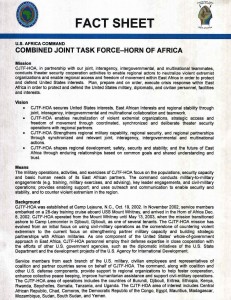2014-12-11 By Murielle Delaporte
During her visit to Djibouti, M. Delaporte was able to talk with with Public Affairs Officers Lieutenant-Colonel Jeffrey Jones (USAF, CJTF-HOA) and Lieutenant Seamus Nelson (US Navy, Djibouti), on November 12th, 2014 at Camp Lemonnier .
They provided a very clear look at the transformation of the base used by the American forces in Djibouti.
”We are starting the transition between an expeditionary base to an enduring base “, explains Lieutenant Nelson as he and Lieutenant-Colonel Jones drive through Camp Lemonnier, the former French Foreign Legion camp in Djibouti where the US Navy now hosts the Combined Joint Task Force –Horn of Africa (CJTF-HOA).

It all started in the aftermath of 9/11 with the establishment of the CJTF-HOA at Camp Lejeune in North Carolina in October 2002 :
In November 2002, [CJTF-HOA] service members embarked on a 28-day training cruise aboard USS Mount Whitney, and arrived in the Horn of Africa December 8th, 2002.
CJTF-HOA operated from the Mount Whitney until May 13th, 2003, when the mission transitioned ashore to Camp Lemonnier in Djibouti, as one of several tenants.
The CJTF-HOA mission has evolved from an initial focus on using civil-military operations as the cornerstone of countering violent extremism to the current focus on strengthening partner military capacity and building strategic partnerships with African militaries,” reads the official presentation [link] of the Djibouti-based Task Force.[ref] See Fact Sheet, PDF[/ref]
Growing Responsibilities
As the mission evolved and as the threats in the direct proximity of the base have grown – ranging from the Shebabs in “Somaliland” located at less than 15 miles and visible from Camp Lemonnier to political unrest threatening the lives of US citizens such as was the case in South Sudan a year ago leading to the implementation of a crisis response initiated from Djibouti -, the force itself keeps growing.[ref] See :
http://breakingdefense.com/2014/02/lessons-from-marines-special-africa-force-juba-the-anti-bengahzi/
https://sldinfo.com/special-purpose-magtf-cr-the-juba-operation/[/ref]
The force started from a small group of about 30 people, then grew until recently to 2400 military personnel reaching today 5000 men and woman.
As the CJTF-HOA transitioned onto land from a ship off the coast, the Marines started out with about 50 to 60 acres to live on. Nowadays the force includes US Navy and Marines components, but also Army, Air Force and even one Coast Guard personnel is part of the leadership team of the Coastal Riverine Station CRS-1 (which is run by a Navy Commander),”recalls Lieutenant Nelson.
Born out of the USS Cole experience, CRS 1 is in charge of ensuring port security for US ships entering Djibouti.[ref] The attack on the USS Cole happened in October 2000 while the destroyer was refueling in the harbor of Aden and caused the death of 17 sailors and injured 39 servicemen (see: http://www.911memorial.org/uss-cole-bombing).
The French military health service stationed in Djibouti played a crucial role in transporting patients in critical condition to the French military Boussard Hospital where they were stabilized. Today, there is, in this area as well, an ongoing cooperation and capability sharing among the various international forces stationed in Djibouti.[/ref]

This is an area in which US and French cooperation is growing (in this case with the French Navy and “Fusiliers marins,” while both forces train the Djiboutian Coast Guard on a regular basis [ref]See: http://www.operationnels.com/2014/11/16/special-djibouti-la-marine-nationale-soutient-les-forces-navales-a-djibouti/ and the upcoming Special issue on the French forces in Djibouti to be published in the March issue of the quarterly “Opérationnels SLDS.”[/ref]
The missions of the Task Force and the Camp Command as a whole are however multifold, held under the overall Command of AFRICOM, but also in connection with other US players (State Department; USAID : etc), as well as NATO and the United Nations, and dealing with a wide range of countries sorted out by “Areas of responsibility” and “Areas of Interest”
The US forces stationed in Djibouti mostly work with their African counterparts, but they entertain a very good working relationship with other foreign forces present nearby, such as the French forces which are now second in rank in terms of staff since the re-deployment in 2011 of the 13th DBLE (Foreign Legion armored division) to the United Arab emirates.[ref]See: http://www.defense.gouv.fr/terre/actu-terre/la-13e-dble-quitte-djibouti[/ref]
Other forces, with which liaison officers, briefs and MWR (Moral, Welfare and Recreational) events such as sport games (in particular volley ball tournaments and soccer games) are shared on a regular basis, include as well the Italians and the Japanese.
The CJTF-HOA supporting units currently based in Camp Lemonnier are as follows:
First, the 449th Air Expeditionary Group which is in charge in particular of personnel recovery and CSAR missions, as well as personnel air drop, and logistical transport.
The unit is currently equipped with one HC-130 “King”, one C-130 J “Super Hercules ”and HH-60 “Pave Hawks,” but the numbers and type of equipment changes over time and circumstance.
And there is a new combat aircraft loading area is under construction since June in order to accommodate permanently-based aircrafts as well the ones transiting through the camp;
Second, there are Civil Affairs Teams.
Third, there is an East African Response Force which focuses “on force protection and mil-to-mil engagements with partner nations.”

Growing Challenges
Growing missions and responsibilities leads to growing staff and growing management challenges, the first one being how to lodge and support more and more people – the above-mentioned 5000 military personnel, but also the contractors which include about 1000 Djiboutians – on a limited space in the harsh environment characterizing this part of the world and in quasi-autarkic conditions characterizing the American approach to forward basing.
Because of historical and cultural differences, the French presence in Djibouti is split in various locations embedded within the city itself whereas Camp Lemonnier is located by the airfield.
The airfield is shared with the Djiboutians and the French as well.
And the Red Sea basing area has grown in a similar way to KAIA (Kabul International Airport).
First, there is a constant struggle for usable space.
Little by little, 10-people tents are being replaced by CLUs or “Container Living Units.”
“We call our living quarters “Cluville”; in Afghanistan, they called these units CHUs for “Container Housing Units”.
Since we just renewed our lease with the Djiboutians for 10 years with two additional 10 year lease possible, we have to think of infrastructure for up to 30 years on a space now set for 608 acres.
That is why we have to think up rather than wider.
Hence the stacking of CLUs to 2 or 3 levels”, explains Lieutenant Nelson.
Then there is the struggle with heat.
Energy saving has been a constant concern while building Cluville since June 2014, because Djibouti sustains very high temperatures part of the year and extremely high temperatures the rest of the year.
Air conditioning accounts for 70% of Camp Lemonnier’s energy consumption and drastic measures have been taken to cut it down.
“Stacking units are being tested in order to save both space and energy: their second level has insulation above and below and they tend to be built in the shadow whenever possible.
Old AC units are being replaced with more efficient ones.
All power plants units are also being tied together in one single grid.
They are consolidated and old units are also replaced with new ones which life span is 10% longer, hence reducing maintenance and replacement costs.
All these various efforts have led just in the course of one year to an overall energy consumption reduction and savings amounting to 20% “, stresses Lieutenant Nelson.
Then there is the constant struggle to deal with dust and its impacts on men and materiel.
Nature is rough in Djibouti and a very fine dust – worse than in Afghanistan or Western Africa according to soldiers able to compare thanks to their past deployments – infiltrates everywhere.
Dust is the reason the potential of solar panels as a way to reduce energy costs is reduced.
Dust – and what it becomes of it when heavy rains happen – are the reason hangars and roads are being built.
Trucks try to keep it down by constantly watering down the dirt roads still predominant on the base. And the water for this task comes from reclaimed water from the waste water treatment plant, which highlights the focus of the base on base efficiencies wherever possible.
There is an ongoing challenge as well to provide for effective support and security for the forces operating from the base.
Most of this construction work is being outsourced either locally or to contracting companies such as KBR and B.L. Harbert International, which often hires third country nationals such as Filipinos.[ref] See in particular: http://www.defenceweb.co.za/index.php?option=com_content&view=article&id=36680:us-navy-contracts-two-companies-to-expand-renovate-camp-lemonnier&catid=47:Logistics&Itemid=110[/ref]
KBR’s tasks involve construction, repair and renovation in various areas such as a wastewater treatment system and an incinerator.
The base is indeed completely self-reliant producing its own water from wells, its own energy through fuel generators, but trying to minimize its footprint as best as possible by taking care of its own trash for instance.
KBR is also in charge of the fire department and firefighter training on the base.
Improving daily living conditions for the US military personnel often deployed for 11 months in a row without their families is the bedrock to ensure that the tactical military challenges are met with success in an increasingly difficult environment.
In comparison, French military personnel are deployed either on a short term basis – usually 4 month periods – without their families, or a long-term basis of 3 years with their families: because of French traditional presence in this part of the world, Djibouti’s conditions of leaving and deployment for the French military are rather unique.
The difficulty of the missions such as mil-to-mil training in Africa cannot be underestimated and requires a long-lasting commitment, but results are there and evidenced by the decline of piracy in the Gulf of Aden in the recent years.[ref]As seen in another part of the African continent, i.e. Nigeria in the fight against Boko Haram (see: Les Etats-Unis face à Boko Haram : les limites de la formation militaire dans la lutte anti-terroriste, a version of which was published in TTU, December 3rd, 2014, page 2)[/ref]
Editor’s Note: Recent articles by the same author related to this article are as follows:
https://sldinfo.com/celebrating-veterans-day-2014-in-djibouti/
https://www.mca-marines.org/leatherneck/2014/04/filling-gap
http://breakingdefense.com/2014/02/lessons-from-marines-special-africa-force-juba-the-anti-bengahzi/
https://sldinfo.com/special-purpose-magtf-cr-the-juba-operation/
Obama : le double-bail de Djibouti, TTU, May 19th, 2014
Les Etats-Unis face à Boko Haram : les limites de la formation militaire dans la lutte anti-terroriste, TTU, December 3rd, 2014
CJTF-HOA : de l’USS Mount Whitney à « Cluville», TTU, November 26th, 2014
Editor’s Note: The slideshow above shows U.S. Marines with Combat Logistics Battalion 11, 11th Marine Expeditionary Unit (MEU), fire a 240B medium machine gun from the turret of a Humvee during a live-fire static crew-served weapons range as part of sustainment training at D’Arta Plage, Djibouti, Nov. 5.
The 11th MEU is deployed as a theater reserve and crisis response force throughout U.S. Central Command and the U.S. 5th Fleet area of responsibility.
Credit:11th MEU:11/7/14
- In the second photo, U.S. Marine Corps Sgt. Dylan S. Large with Charlie Company, 1st Light Armored Reconnaissance detachment, Battalion Landing Team 2nd Battalion, 1st Marines, 11th Marine Expeditionary Unit (MEU), aims a French FAMAS assault rifle alongside French armed forces from the 1st Spahis Regiment during sustainment training in D’Arta Plage, Djibouti, Nov. 5.
- In the third photo, the Casualty Evacuation (CASEVAC) heavy team comprised of Lt. Shannon A. Meyer, left, an emergency nurse and native of Seaford, N.Y., and Lt. Cmdr. Anthony M. Bielawski, second left, an emergency medicine physician and native of Bay City, Michigan, both with Combat Logistics Battalion 11, 11th Marine Expeditionary Unit (MEU).
- In the fourth photo, Lt. Shannon A. Meyer, an emergency nurse and native of Seaford, New York, with Combat Logistics Battalion 11, 11th Marine Expeditionary Unit (MEU), speaks with an MV-22B Osprey crew chief from Marine Medium Tiltrotor Squadron, 11th MEU, during a response drill as part of Casualty Evacuation (CASEVAC) sustainment training at D’Arta Plage, Djibouti, Nov. 5.
- In the fifth photo, U.S. Marine Corps Sgt. Robert J. Scarpello, left, an explosive ordnance disposal technician with Combat Logistics Battalion 11, 11th Marine Expeditionary Unit (MEU), and native of Sellersville, Pa., gives a period of instruction on the compact metal detector during a counter-improvised explosive device exercise as part of sustainment training at D’Arta Plage, Djibouti, Nov. 6.
- In the sixth and seventh photos, a UH-1Y Super Huey with Marine Medium Tiltrotor Squadron 163 (Reinforced), 11th Marine Expeditionary Unit (MEU), takes off after delivering supplies to Marines conducting sustainment training at D’Arta Plage, Djibouti, Nov. 7.
- In the final photo, U.S. Marine Corps Cpl. David S. Chandler, a light armored vehicle crewman with Charlie Company, 1st Light Armored Reconnaissance detachment, Battalion Landing Team 2nd Battalion, 1st Marines, 11th Marine Expeditionary Unit (MEU), and native of Dublin, California, leaves a forward operating base during a security patrol as part of sustainment training in D’Arta Plage, Djibouti, Nov. 6.
The video above shows Soldiers from 1st Infantry Division, 2nd Battalion, 16th Infantry Regiment clear a compound from insurgent forces during a base defense exercise on Camp Lemonnier, Djibouti on July 10, 2014.
Credit: Combined Joint Task Force – Horn of Africa Combat Camera, 7/10/14
For a look at the general strategic situation and role of Djibouti see the following Chatham house paper:
Chatham House Paper on Djibouti








